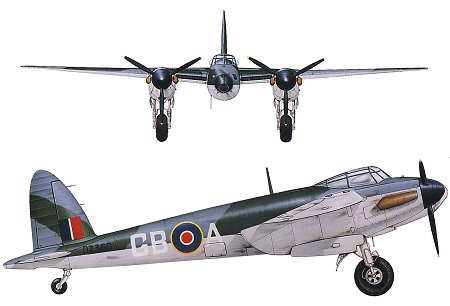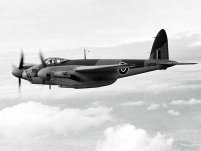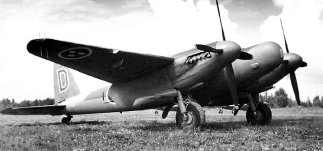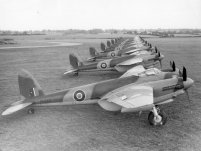
De Havilland Mosquito
The Mosquito came from obscurity and rose to glory. Official interest was lukewarm when de Havilland made a private proposal for a fast, twin engined, two man bomber. But its performance was so outstanding that it went into production.
The Mosquito was fast and nimble, and performed well in an attack on Gestapo headquaters in Oslo which was thwarted the dud bombs. High speed, precision air strikes became the stock in trade for the Mosquito, which also adapted quickly to other roles and missions.
Almost four dozen versions of the Mosquito carried out every wartime duty, from whisking spies behind the lines to photo mapping enemy territory. Precision bombing of special targets persisted throughout the war - Amiens prison, Gestapo headquaters in the Hague, V-1 'buzz bomb' launching sites. Each time, the Mosquito demonstrated its unique ability to strike fast, hit hard and get away clean.
More than a dozen overseas air forces used Mosquito in the years after the war.
We think of Mosquitoes fighting the Luftwaffe or pressing relentlessly to bomb their targets, but it was probably the most useful Allied aircraft of World War II. Fighter, bomber, night-fighter, attack aircraft, torpedo-bomber, transport - these are just a few of the roles that de Havviland's design performed with miraculous success. The Mosquito was all the more impressive as it was mostly made of wood. The RAF virtually ignored the aircraft at first, but it became one of its most valuable planes.
|

|
 |
 |
 |
| The Mosquito could fly almost unchallenged over occupied Europe, day or night, and deliver devastating attacks from rooftop height. The bomber versions were as fast and agile as fighters, and could generally excape from an enemy attacker. |
This brightly painted PR.Mk 16 was an unarmed photographic aircraft. These Nosquitoes performed the hazardous task of gathering inteligence from enemy territory, relying on speed for safety. |
The Mosquito became a very important part of t he bomber offensive, target making for the larger Lancaster and Halifax force. |
|
De Havilland Mosquito (Technical Specification) |
| Role |
High speed light bomber |
| Manufacturer |
De Havilland |
| Maximum Speed |
612 kmh (379 mph) |
| Maximum Range |
3,000 km (1,860 miles) |
| Ceiling |
10,500 meters (34,450 feet) |
Weight
Empty
Maximum Takeoff |
6,400 kg 14,080 lbs)
10,200 kg (22,440 lbs) |
Dimensions
Wingspan
Length
Height
Wing Area |
16.51 meters (54 ft)
12.43 meters (41 ft)
4.65 meters (15 ft)
42.18 square meters (454 sq ft) |
| Engines |
Two Rolls-Royce Merlin 21 inline piston engines each providing 918-kW (1,230 hp) |
| Armament |
Four 227 kg (500 lbs) bombs internal bombload
|
Photo Gallery
Click here to submit your photo
| Have A Passion For Aircraft? |
Subscribe to our 14 series FREE newsletter
delivered weekly on World War 2 Aircraft factfile... |
| NB:- We hate spam as much as you do, so your email address will NEVER be shared with or sold to anyone else. That's a Guarantee. |
|
|





